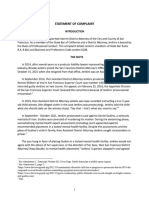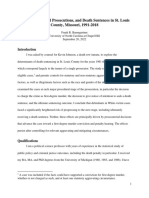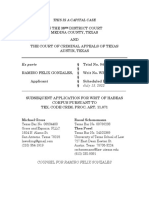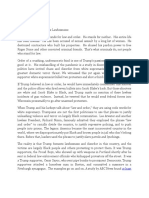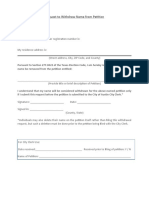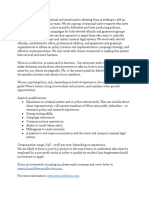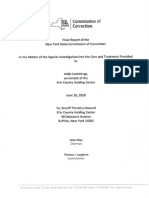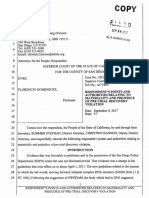Professional Documents
Culture Documents
LA County DA Opposition SB 10
Uploaded by
Jennifer0 ratings0% found this document useful (0 votes)
1K views6 pagesLA DA opposition to bail reform
Original Title
LA County DA Opposition SB 10 (1)
Copyright
© © All Rights Reserved
Share this document
Did you find this document useful?
Is this content inappropriate?
Report this Document0 ratings0% found this document useful (0 votes)
1K views6 pagesLA County DA Opposition SB 10
Uploaded by
JenniferYou are on page 1of 6
SR 3%, LOS ANGELES COUNTY DISTRICT ATTORNEY'S OFFICE
+ SACRAMENTO LEGISLATIVE OFFICE
Pg IACKIE LACEY «District Attornay DANIEL FELIZZATTO + Legislative Advocate
JOHN K. SPILLANE « Chief Deputy District Attorney
e
%
4s
*
oF 108
April 14, 2017
‘The Honorable Robert Hertaberg
yrnia State Senate
Sint Capitol, Room 4038 a
Sacramento, CA 95814
SENATE BILL 10 (HERTZBERG)
OPPOSE
Senate Appropriations Committee
Dear Senator Hertzberg:
The Los Angeles County District Attomey’s Office regrets to inform you that our office respectfully
opposes Senate Bill 10.
SB 10 would create a presumption of own-recognizance release (O/R) and significantly changes monetary
bail, Monetary bait will still be allowed when conditions of an O/R release cannot assure a defendant's,
return to court, or where a defendant poses a risk to public safety or to a victim, When monetary bail is
imposed the court must set the amount based upon the defendant's ability to pay.
Our office believes that changes to California’s current bail/pre-trial release system should be made and
are willing to work with all interested parties in crafting well thought out changes that will assist in
achieving the goal of eliminating the need for unnecessary pre-trial detention, while at the same time
ensuring the defendant’s appearance at their court hearings and protecting public safety.
While our office believes SB 10 is well-intentioned, the proposed changes are so dramatic itis difficult to
determine what the real world impacts these changes will have on California’s criminal justice system,
Devising a bail scheme such as the one proposed by this bill raises the following concerns:
‘© How does a bail amount which is based upon a defendant's ability to pay, assure the defendant
will return to court? If the amount is only what the defendant can afford there is no real
consequence if the defendant fails to appear in court.
«The proposed bail scheme does not adequately assess the risk to public safety posed by
defendants accused of things such as use of a weapon, serious injuries, multiple victims, and a
defendant's prior criminal history because the bail schedule is eliminate and the these factors are
not adequately considered in the proposed guidelines for the risk assessment tool.
‘© The proposed legislation negleets to consider the considerable risk of continuing criminal conduct
by persons arrested but not detained for fraud-related crimes, Under the proposed statutes, any
person arrested for felony fraud offenses will be released, without consideration of the risk of
1100 K Strost, Suite 404
Sacramento, CA 95814
(916) 442-0668,
Fax: (916) 444.8729
April 14, 2017
Page ‘Iwo
continued criminal conduct, continued generation of criminally obtained revenue, and continued
victimization of the publi.
‘The proposed legislation removes any deterrent impact of fraud prosecution by eliminating any
risk of detention or pretrial incarceration. In addition, adoption of the “least restrictive level
necessary” standard” fails to take into consideration the often sizeable resources available to
fraud defendants, which under the current system would be reviewed pursuant to source of bail
motions. The proposed legislation renders impotent the provisions of 1275.1 because the bailable
amount will no longer refleet the enormity of the chargeable criminal fraud, the number of
impacted victims, the pervasiveness of the scheme, or the potential for the criminal conduct to
continue. Bernie Madoff, under these statutes, would be immediately released from county jail,
despite the enormous damage his criminal conduct inflicted. Robert Rizzo and the entire Bell City
‘Council would be immediately released, despite the enormous damage their criminal conduct
inflicted. Currently, we have defendants who committed more than $174 milion in healthcare
fraud, luring people into their rehab business by lying about being a residential treatment facility
when they were not, and by stealing people’s identities to obtain additional insurance policies
which paid for services the purported clients did not receive, then using the proceeds from the
fraudulent billing to pay for their operation and their big salaries. ‘These people would have been
released at the time of their arrest, despite the enormous injury they inflicted through their de
Fraud is incredibly difficult to detect. Unlike violent crimes, that leave victims physically
‘wounded, fraud vietims often do not know they've been victimized until long after the crime has
been completed. Detection of fraud committed by released detainees will necessarily require
commitment of additional scarce resources to ensure that the released detainee does not continue
to offend. The opportunity to monitor the released detainee’s conduct is minimal, because 20
post release conditions can be imposed that cost the released detainee any money.
‘The amendment to Penal Code section 825 states that a defendant will be arraigned on a Friday
when arvested on a Wednesday, unless the Friday is a court holiday. In that case, the defendant
shall be brought to court on a Thursday. What happens when a defendant is arrested on the
‘Wednesday before Thanksgiving, and Thursday and Friday are court holidays? What day shall
the defendant appear before a magistrate?
When a Friday is a court holiday, a Wednesday arrestee must be charged by Thursday. In the real
world when someone is arrested on Wednesday at 11:00 p.m., SB 10 expects that the police will
complete the arrest and booking reports, present them to the DA on Thursday, and expect the DA
to make a careful charging decision in time for afternoon court arraignment, This is virtually
spossible in the real world.
‘The proposed amendment to Penal Code section 1269b(d) states that the risk assessment must be
done within an unspecified period after arrest. Given the likelihood that the period of time to
‘assess the defendant's risk to public safety will be relatively short, it seems impracticable that a
real risk assessment will be conducted, especially considering that subsection (g) also makes it
‘mandatory that the defendant be released even if the risk assessment is not available, ic, "the fact
that the court bas not received the report required under this section shall not preclude the
release.” Release of a defendant without a risk assessment report poses serious public safety
concerns,
April 14, 2017
Page Three
‘+ The timing of the risk assessment report and the defendant’s release may be in conflict with
provisions of Marsy’s Law which states that victims are given the right to be included in all legal
proceedings, including the release from custody of their offenders, after arrest but before
‘+ The proposed amendment to Penal Code section 1269b provides that for misdemeanor arrests,
unless otherwise specified, the arrestee shall be released without conditions after signing a release
agreement. Our office is concerned that list of specified misdemeanors does not include repeat
violations of California’s DUI statutes (Vehiicle Code sections 23152 and 23153), The bill also
provides that all non-violent felons shall be released without appearing before a judge for a court
hearing, We are concerned that the list of offenses that require a hearing should include erimes
such as stalking (Penal Code section 646.9), violating a protective order or restraining order
(Penal Code section 273.6), violation of a court order, criminal threats (Penal Code section 422),
solicitation of a serious crime (Penal Code section 6534), and conspiracy to commit a violent
crime (Penal Code section 182).
* The proposed amendment to Penal Code section 1275(a)(1) state factors that judges shall
consider in making a pretrial release or detention decision. One of the factors is the defendant's
minal record, however this is not consistent with Penal Code section 1318.3(b)(5), which states
that that the risk assessment tool (upon witich the judge shall rely in making the pre-trial
detention decision), shall not give undue weight to factor such as a defendant's criminal history.
Criminal history should be an aggravating factor in determining risk to public safety, and is an
important factor in determining pre-trial release.
‘+ The proposed amendment to Penal Code section 1275(a)(2) lists factors a judge shall consider
‘when determining seriousness of the offense, but does not include such factors as vulnerability of
the victim, multiple victims, prior DUIs, or substantial financial loss in cases of major fraud or
thefts.
* The proposed amendment to Penal Code section 1275(b) requires the judge to make a pre-trial
release or detention decision without unnecessary delay or within 48 hours. This will impact
victim's rights under Marsy's Law.
‘+ The proposed amend to Penal Code section 1275a(b)(1) states if the judge determines that pre~
il release will not assure the defendants return to court or the safety of the victim or the public,
the judge can impose the least restrictive non-monetary conditions which will reasonably assure
the defendant's appearance and victim and public safety. It is counter-intuitive that "least
restrictive" will still protect victims and the public. Instead of “least restrictive, the language
should state the “most effective” assure a defendant’s return to court and the safety of the victim
and the public are safe.
* The amendment to Penal Code section 1275a(b)(3) specifies that a detainee shall not be required
to pay for any nonmonetary eonditions of release. This would mean that, if a court were to order
a fraud defendant to relinquish control of his fraud-producing company, the order would be
rendered unenforceable because the defendant could successfully claim that the order is a “non-
‘monetary condition” that will cost money. ‘The costs for these services (GPS monitoring,
SCRAM units, drug and/or alcohol sereening for examples) will be quite large and will have
significant fiscal impacts on whoever is responsible for these costs (either the State or county).
You might also like
- Brooke Jenkins State Bar ComplaintDocument18 pagesBrooke Jenkins State Bar ComplaintJenniferNo ratings yet
- Baumgartner Report 20sept2022 FinalDocument30 pagesBaumgartner Report 20sept2022 FinalJenniferNo ratings yet
- 2022-09-02 - Phila DAO (Krasner) - Petition For Review ExhibitsDocument83 pages2022-09-02 - Phila DAO (Krasner) - Petition For Review ExhibitsJenniferNo ratings yet
- Wren Collective Job Posting Aug 2021Document1 pageWren Collective Job Posting Aug 2021JenniferNo ratings yet
- Save Austin Now FailsDocument2 pagesSave Austin Now FailsJenniferNo ratings yet
- 2022.07.1 Statement of Thea Posel and Raoul Schonemann Re Clemency DenialDocument1 page2022.07.1 Statement of Thea Posel and Raoul Schonemann Re Clemency DenialJenniferNo ratings yet
- 2022.07.11 Supplemental Letter Requesting 30-Day Reprieve With AppendicesDocument15 pages2022.07.11 Supplemental Letter Requesting 30-Day Reprieve With AppendicesJenniferNo ratings yet
- Gonzales Clemency Press ReleaseDocument2 pagesGonzales Clemency Press ReleaseJenniferNo ratings yet
- 2022.06.30 Ramiro Gonzales - Subsequent 11.071 ApplicationDocument147 pages2022.06.30 Ramiro Gonzales - Subsequent 11.071 ApplicationJenniferNo ratings yet
- 2022.06.29 Letter Requesting 30-Day Reprieve With AppendicesDocument16 pages2022.06.29 Letter Requesting 30-Day Reprieve With AppendicesJenniferNo ratings yet
- An Open Letter From Prosecutors On Trump's LawlessnessDocument3 pagesAn Open Letter From Prosecutors On Trump's LawlessnessJennifer0% (1)
- Dear Los Angeles County Deputy District AttorneysDocument2 pagesDear Los Angeles County Deputy District AttorneysJennifer100% (1)
- In Re SoaresDocument3 pagesIn Re SoaresJennifer100% (1)
- SQ - Urgent Memo.6.15.20.Document7 pagesSQ - Urgent Memo.6.15.20.JenniferNo ratings yet
- Request To Withdraw Name From PetitionDocument1 pageRequest To Withdraw Name From PetitionJenniferNo ratings yet
- Arundel ComplDocument39 pagesArundel ComplJenniferNo ratings yet
- Job AnnouncementDocument2 pagesJob AnnouncementJenniferNo ratings yet
- Roy Cooper Letter April 3Document4 pagesRoy Cooper Letter April 3JenniferNo ratings yet
- Arundel ComplDocument39 pagesArundel ComplJenniferNo ratings yet
- Final DA Bail Letter March 6Document2 pagesFinal DA Bail Letter March 6Jennifer100% (1)
- New York State Commission of Correction's 5 Worst JailsDocument73 pagesNew York State Commission of Correction's 5 Worst JailsAaronBesecker100% (1)
- Final DA Bail Letter March 6Document2 pagesFinal DA Bail Letter March 6Jennifer100% (1)
- Foil # 18-F-137Document33 pagesFoil # 18-F-137WGRZ-TVNo ratings yet
- 2015-09-29 - Petition For Writ of Habeas Corpus (PWHC)Document39 pages2015-09-29 - Petition For Writ of Habeas Corpus (PWHC)JenniferNo ratings yet
- Meek Mill Per CuriamDocument4 pagesMeek Mill Per CuriamJenniferNo ratings yet
- Facebook Screen Shot 1Document1 pageFacebook Screen Shot 1JenniferNo ratings yet
- IndictmentDocument1 pageIndictmentJenniferNo ratings yet
- 2017-09-08 - Respondent's Points and Authorities Relating To Materiality and Prejudice of Pre-Trial Discovery ViolationDocument45 pages2017-09-08 - Respondent's Points and Authorities Relating To Materiality and Prejudice of Pre-Trial Discovery ViolationJenniferNo ratings yet
- Dominguez Florencio - HC 22238 SCD 230596 D060019 - Orde (Brady Interp Protocol)Document36 pagesDominguez Florencio - HC 22238 SCD 230596 D060019 - Orde (Brady Interp Protocol)JenniferNo ratings yet
- The Subtle Art of Not Giving a F*ck: A Counterintuitive Approach to Living a Good LifeFrom EverandThe Subtle Art of Not Giving a F*ck: A Counterintuitive Approach to Living a Good LifeRating: 4 out of 5 stars4/5 (5783)
- The Yellow House: A Memoir (2019 National Book Award Winner)From EverandThe Yellow House: A Memoir (2019 National Book Award Winner)Rating: 4 out of 5 stars4/5 (98)
- Never Split the Difference: Negotiating As If Your Life Depended On ItFrom EverandNever Split the Difference: Negotiating As If Your Life Depended On ItRating: 4.5 out of 5 stars4.5/5 (838)
- Shoe Dog: A Memoir by the Creator of NikeFrom EverandShoe Dog: A Memoir by the Creator of NikeRating: 4.5 out of 5 stars4.5/5 (537)
- The Emperor of All Maladies: A Biography of CancerFrom EverandThe Emperor of All Maladies: A Biography of CancerRating: 4.5 out of 5 stars4.5/5 (271)
- Hidden Figures: The American Dream and the Untold Story of the Black Women Mathematicians Who Helped Win the Space RaceFrom EverandHidden Figures: The American Dream and the Untold Story of the Black Women Mathematicians Who Helped Win the Space RaceRating: 4 out of 5 stars4/5 (890)
- The Little Book of Hygge: Danish Secrets to Happy LivingFrom EverandThe Little Book of Hygge: Danish Secrets to Happy LivingRating: 3.5 out of 5 stars3.5/5 (399)
- Team of Rivals: The Political Genius of Abraham LincolnFrom EverandTeam of Rivals: The Political Genius of Abraham LincolnRating: 4.5 out of 5 stars4.5/5 (234)
- Grit: The Power of Passion and PerseveranceFrom EverandGrit: The Power of Passion and PerseveranceRating: 4 out of 5 stars4/5 (587)
- Devil in the Grove: Thurgood Marshall, the Groveland Boys, and the Dawn of a New AmericaFrom EverandDevil in the Grove: Thurgood Marshall, the Groveland Boys, and the Dawn of a New AmericaRating: 4.5 out of 5 stars4.5/5 (265)
- A Heartbreaking Work Of Staggering Genius: A Memoir Based on a True StoryFrom EverandA Heartbreaking Work Of Staggering Genius: A Memoir Based on a True StoryRating: 3.5 out of 5 stars3.5/5 (231)
- On Fire: The (Burning) Case for a Green New DealFrom EverandOn Fire: The (Burning) Case for a Green New DealRating: 4 out of 5 stars4/5 (72)
- Elon Musk: Tesla, SpaceX, and the Quest for a Fantastic FutureFrom EverandElon Musk: Tesla, SpaceX, and the Quest for a Fantastic FutureRating: 4.5 out of 5 stars4.5/5 (474)
- The Hard Thing About Hard Things: Building a Business When There Are No Easy AnswersFrom EverandThe Hard Thing About Hard Things: Building a Business When There Are No Easy AnswersRating: 4.5 out of 5 stars4.5/5 (344)
- The Unwinding: An Inner History of the New AmericaFrom EverandThe Unwinding: An Inner History of the New AmericaRating: 4 out of 5 stars4/5 (45)
- The World Is Flat 3.0: A Brief History of the Twenty-first CenturyFrom EverandThe World Is Flat 3.0: A Brief History of the Twenty-first CenturyRating: 3.5 out of 5 stars3.5/5 (2219)
- The Gifts of Imperfection: Let Go of Who You Think You're Supposed to Be and Embrace Who You AreFrom EverandThe Gifts of Imperfection: Let Go of Who You Think You're Supposed to Be and Embrace Who You AreRating: 4 out of 5 stars4/5 (1090)
- The Sympathizer: A Novel (Pulitzer Prize for Fiction)From EverandThe Sympathizer: A Novel (Pulitzer Prize for Fiction)Rating: 4.5 out of 5 stars4.5/5 (119)
- Her Body and Other Parties: StoriesFrom EverandHer Body and Other Parties: StoriesRating: 4 out of 5 stars4/5 (821)
